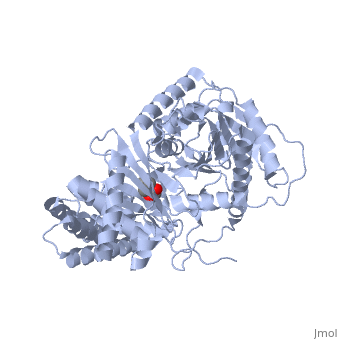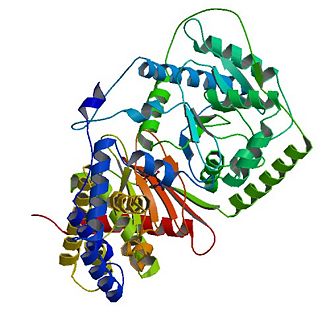Carnitine acetyltransferase
From Proteopedia
(Difference between revisions)
| Line 5: | Line 5: | ||
'''Carnitine acyltransferases''' are a large family of enzymes that play a main role in cellular energy metabolism, i.e. fatty acid oxidation. These enzymes catalyze the reversible exchange of acyl groups (which derive from fatty acids) between coenzyme A and carnitine. | '''Carnitine acyltransferases''' are a large family of enzymes that play a main role in cellular energy metabolism, i.e. fatty acid oxidation. These enzymes catalyze the reversible exchange of acyl groups (which derive from fatty acids) between coenzyme A and carnitine. | ||
Carnitine acyltransferases include three different classes of enzymes which are known as carnitine acetyltransferases (CrATs), carnitine octanoyltransferases (COTs) and carnitine palmityltransferases (CPTs). "The three classes differ in their acyl group specificity as well as their localization." <ref name="JBC">Donghai Wu‡, Lakshmanan Govindasamy§, Wei Lian‡, Yunrong Gu‡, Thomas Kukar‡,Mavis Agbandje-McKenna§, and Robert McKenna§¶.Structure of Human Carnitine Acetyltransferase.Published, JBC Papers in Press, January 31, 2003 DOI 10.1074/jbc.M21235620</ref>. Nevertheless functional conservation between the carnitine acyltransferases can be observed. That's why the focus of this entry is on the structure of carnitine acetyltransferase as a representitive of carnitine acyltransferases. Determining the structure and thus the molecular basis for fatty acid transfer is needed for drug development. Being major enzymes in fatty acid oxidation carnitine acyltransferases are viewed as promising targets which can be used to develop successful therapeutics against type 2 diabetes, obesity and other human diseases. | Carnitine acyltransferases include three different classes of enzymes which are known as carnitine acetyltransferases (CrATs), carnitine octanoyltransferases (COTs) and carnitine palmityltransferases (CPTs). "The three classes differ in their acyl group specificity as well as their localization." <ref name="JBC">Donghai Wu‡, Lakshmanan Govindasamy§, Wei Lian‡, Yunrong Gu‡, Thomas Kukar‡,Mavis Agbandje-McKenna§, and Robert McKenna§¶.Structure of Human Carnitine Acetyltransferase.Published, JBC Papers in Press, January 31, 2003 DOI 10.1074/jbc.M21235620</ref>. Nevertheless functional conservation between the carnitine acyltransferases can be observed. That's why the focus of this entry is on the structure of carnitine acetyltransferase as a representitive of carnitine acyltransferases. Determining the structure and thus the molecular basis for fatty acid transfer is needed for drug development. Being major enzymes in fatty acid oxidation carnitine acyltransferases are viewed as promising targets which can be used to develop successful therapeutics against type 2 diabetes, obesity and other human diseases. | ||
| - | |||
| - | |||
== Biological function == | == Biological function == | ||
| Line 35: | Line 33: | ||
The exact role of the '''trimethylammonium group''' during carnitine binding hasn’t been fully revealed yet. Carnitine is rather required for catalysis than for binding. Even though the trimethylammonium group has a positive charge on its nitrogen it is not surrounded by negatively charged residues which could balance it. Instead, the trimethylammonium group is situated in a rather hydrophobic environment. | The exact role of the '''trimethylammonium group''' during carnitine binding hasn’t been fully revealed yet. Carnitine is rather required for catalysis than for binding. Even though the trimethylammonium group has a positive charge on its nitrogen it is not surrounded by negatively charged residues which could balance it. Instead, the trimethylammonium group is situated in a rather hydrophobic environment. | ||
| - | There are only slight conformational changes in the enzyme upon carnitine binding.“The only significant conformational difference in the active site between the free enzyme and the carnitine complex is in the side chain of <font color='#90E050'>'''serine454'''</font>, which adopts a different rotamer to have better hydrogen-bonding interactions with the carboxylate of carnitine.” <ref name="structure" / | + | There are only slight conformational changes in the enzyme upon carnitine binding.“The only significant conformational difference in the active site between the free enzyme and the carnitine complex is in the side chain of <font color='#90E050'>'''serine454'''</font>, which adopts a different rotamer to have better hydrogen-bonding interactions with the carboxylate of carnitine.” <ref name="structure" /> |
==Catalytic Mechanism of Carnitine Acyltransferases== | ==Catalytic Mechanism of Carnitine Acyltransferases== | ||
| Line 48: | Line 46: | ||
== Carnitine acetyltransferase deficiency and diseases == | == Carnitine acetyltransferase deficiency and diseases == | ||
Mutation and dysregulation of CPTs are linked to serious human diseases. Recessive mutations of CPT-I and CPT-IICPT-I and CPT-II are crucial for the beta-oxidation of long-chain fatty acids in the mitochondria by enabling their transport across the mitochondrial membrane. can produce hypoketonemia and hypoglycemia in patients, while CPT-II deficiency is the most common cause of abnormal lipid metabolism in skeletal muscle.Single-point mutations as well as insertions/deletions in the CPT genes can produce the clinical phenotype. The hypoglycemia observed in patients with reduced CPT-I activity suggests that antagonists of CPT-Is may be able to lower blood glucose levels. A covalent CPT-I inhibitor, etomoxir, can lower blood glucose levels in diabetic animals and humans, showing that such inhibitors may be efficacious for the treatment of type 2 diabetes. | Mutation and dysregulation of CPTs are linked to serious human diseases. Recessive mutations of CPT-I and CPT-IICPT-I and CPT-II are crucial for the beta-oxidation of long-chain fatty acids in the mitochondria by enabling their transport across the mitochondrial membrane. can produce hypoketonemia and hypoglycemia in patients, while CPT-II deficiency is the most common cause of abnormal lipid metabolism in skeletal muscle.Single-point mutations as well as insertions/deletions in the CPT genes can produce the clinical phenotype. The hypoglycemia observed in patients with reduced CPT-I activity suggests that antagonists of CPT-Is may be able to lower blood glucose levels. A covalent CPT-I inhibitor, etomoxir, can lower blood glucose levels in diabetic animals and humans, showing that such inhibitors may be efficacious for the treatment of type 2 diabetes. | ||
| - | + | </StructureSection> | |
==3D structures of carnitine acetyltransferase== | ==3D structures of carnitine acetyltransferase== | ||
Revision as of 14:26, 27 May 2015
| |||||||||||
3D structures of carnitine acetyltransferase
Updated on 27-May-2015
1ndb – mCAT – mouse
1t7n – mCAT (mutant)
1ndf – mCAT + carnitine
1t7o – mCAT (mutant) + carnitine
2h3u – mCAT + carnitine + CoA
1t7q – mCAT (mutant) + carnitine + CoA
2h3w – mCAT (mutant) + hexanoylcarnitine + CoA
2h3p – mCAT + Carnitine + acetyl-CoA
1ndi – mCAT + CoA
1s5o – hCAT + carnitine - human
1nm8 – hCAT
References
- ↑ 1.0 1.1 Donghai Wu‡, Lakshmanan Govindasamy§, Wei Lian‡, Yunrong Gu‡, Thomas Kukar‡,Mavis Agbandje-McKenna§, and Robert McKenna§¶.Structure of Human Carnitine Acetyltransferase.Published, JBC Papers in Press, January 31, 2003 DOI 10.1074/jbc.M21235620
- ↑ 2.0 2.1 2.2 Jogl G, Tong L. Crystal structure of carnitine acetyltransferase and implications for the catalytic mechanism and fatty acid transport. Cell. 2003 Jan 10;112(1):113-22. PMID:12526798
- ↑ Lehninger Principles of Biochemistry |ISBN-10: 071677108X | ISBN-13: 978-0716771081 | Publication Date: February 1, 2008 | Edition: 5th
- ↑ 4.0 4.1 Jogl G, Hsiao YS, Tong L. Structure and function of carnitine acyltransferases. Ann N Y Acad Sci. 2004 Nov;1033:17-29. PMID:15591000 doi:10.1196/annals.1320.002
Proteopedia Page Contributors and Editors (what is this?)
Michal Harel, Alexander Berchansky, Alina Spielmann, Ndeye Coumba




